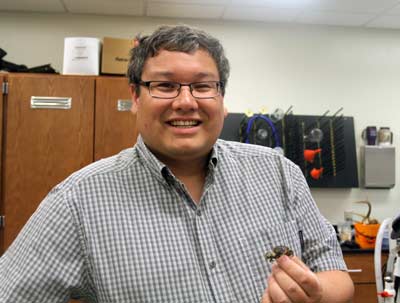July 1, 2014
14-217
Uyeno Serves as Primary Investigator in National Science Foundation Funded Hagfish Project

|
VALDOSTA - For Dr. Theodore “Ted” Uyeno, assistant professor of biology at Valdosta State University, examining how animal evolution has solved problems can assist humans in their quests to solve similar problems. An expert in biomechanics, Uyeno investigates the construction of elusive sea creatures and applies physical principles to create advanced virtual and real-world simulations.
Uyeno and his colleague, Dr. Andrew Clark, assistant professor of biology at the College of Charleston in South Carolina, were recently awarded $600,000 through a grant from the National Science Foundation to examine the biomechanics of the hagfish, a poorly understood slime-producing animal often referred to as a slime eel.
“Hagfish typically live deep at the bottom of the ocean and superficially look like eels,” said Uyeno. “We don’t know much about them, but we do know that they show up on whale carcasses and are the cleanup artists of the ocean. They do not have jaws, but have a raspy tongue that takes large chunks out of their food while they eat. When startled they squirt out fibers and glycoproteins that, when mixed with saltwater, creates a thick mucus. The slime has recently been taken, dried out and spun into fiber that can be used much like cotton or polyester.”
Uyeno added that the hagfish has the ability to tie itself into a knot that runs down its body to remove the slime.
“My job with this project is to examine and then describe how hagfish behaviors work,” said Uyeno. “I plan to describe the morphology of that raspy tongue and figure out how it works in coordination with its knotting body movements to create that surprisingly powerful bite.”
Used to make eel skin wallets, hagfish skin is made of muscles and connective tissues that allow it to tighten, loosen and lock in place.
“We suspect that the properties of the skin are pretty dynamic and contribute to the movement the animal makes,” Uyeno explained. “The biomechanic properties of hagfish skin can be used to develop something very useful. People like loggers, hunters, and hikers depend on ropes to keep them safe while on the job. Maybe there is some hint in hagfish body construction that could be used to create some fail-proof rope that can save these people’s lives.”
Uyeno predicts that the next generation of tools could very likely include deformable elements in their construction similar to the hagfish skin and tongue.
“This project aims to describe a whole new engineering theory that can support this type of biomimetic design,” he said. “The National Science Foundation loved this idea and felt like this project was transformative enough to fund.”
The project includes the collection and study of hagfish at places like Seattle, New Zealand, Mexico and Japan. Uyeno will study Gulf hagfish at Florida State University’s Coastal and Marine Laboratory as well.
Uyeno serves as the primary investigator for the project. He is looking for well-qualified undergraduate and graduate students who are skilled in biology, math or programming to assist with the project.
In previous biomechanical studies, Uyeno’s work has led to discoveries used to patent products. After studying the octopus heart, the scientist was credited with creating a new design of heart stents that allow for greater elasticity to accommodate the force of heartbeats.
“My focus is typically on soft-bodied marine invertebrates,” he said. “I was born and raised near the Rocky Mountains of Canada and the ocean was this really foreign, exciting place for me. My family would drive for days to reach the Pacific Ocean and then I would play with squishy animals in rocky tide pools. During a trip, I remember touching a sea anemone and from that point I was hooked on these and other cool little animals and wanted to explore how they do all the things they do. How does a snail’s foot work? How does an octopus’s arm work?”
After describing how animals work, Uyeno often designs, programs and builds simulations to test these functions. Biomechanics is a relatively new form of science, so many times he must create his own testing devices and equipment to build simulations.
“To get the job done, this field often involves dabbling in computer graphics, physics, engineering, electronics, machining, and programming. However, it is the love of biology that comes first.”
Uyeno holds a Bachelor of Science in biological science and a Master of Science in zoology from University of Calgary as well as a Doctor of Philosophy in biomechanics from University of North Carolina at Chapel Hill. He teaches Human Anatomy and Physiology, Invertebrate Zoology, Biology Freshman Seminar, Comparative Biomechanics, and many independent research credits at VSU. Uyeno has been featured on the popular science podcast, People Behind the Science, in a segment titled “Dr. Ted Uyeno: A Researcher with a Soft Spot for Soft-Tissue Biomechanics.”
Newsroom
- Office of Communications Powell Hall West, Suite 1120
-
Mailing Address
1500 N. Patterson St.
Valdosta, GA 31698 - General VSU Information
- Phone: 229.333.5800
- Office of Communications
- Phone: 229.333.2163
- Phone: 229.333.5983